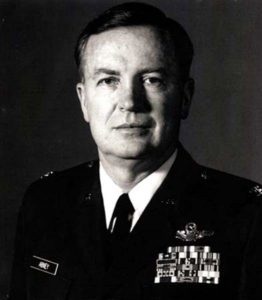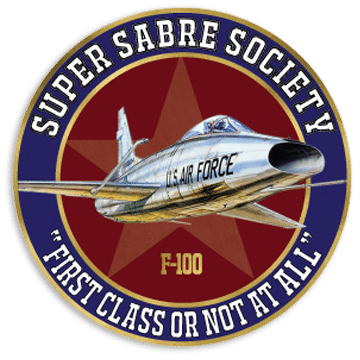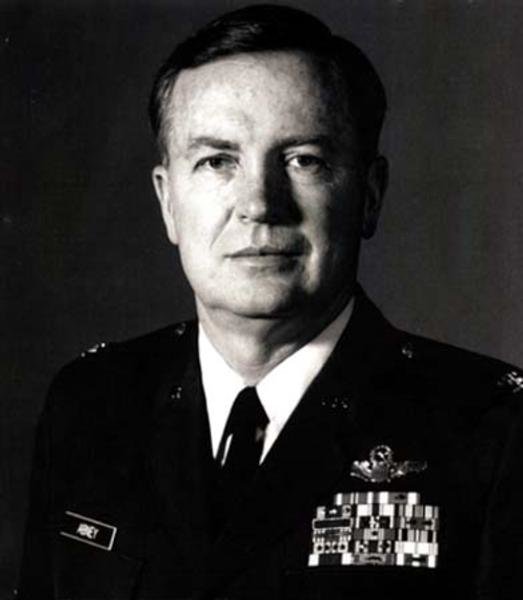Colonel Floyd J. Abney was born September 2, 1936, in Phoenix, Arizona. He enlisted in the Air Force in 1954 immediately following graduation from Winslow High School, Winslow, Arizona. He completed the radar technician course at Keesler Air Force Base, Mississippi, that same year. His subsequent assignments included Mill Valley Air Force Station, California, from 1954 to 1956, Naha Air Base, Okinawa, from 1956 to 1960, and Luke Air Force Base, Arizona, from 1960 to 1961, having then attained the rank of technical sergeant.
At that time, Colonel Abney was selected to attend Officer’s Candidate School and received his commission in 1962. From 1963 to 1964, Colonel Abney completed undergraduate pilot training at Williams Air Force Base, Arizona followed by F 100 training with the 4514th and 4517th Combat Crew Training Squadrons at Luke Air Force Base. He next served with the 81st Tactical Fighter Squadron, Hahn Air Base, West Germany from 1964 to 1966.
In 1966 he returned to Luke Air Force Base as an F-100 instructor pilot with the 451st Combat Crew Training Squadron completing that tour in 1968. Following completion of the fighter weapons instructor’s course at Nellis Air Force Base, Nevada, Colonel Abney served in 1969 and 1970 as an F-100 standardization evaluation pilot and weapons officer with the 352nd Tactical Fighter Squadron at Phan Rang Air Base, Republic of Vietnam. Again returning to Luke Air Force Base at the 451st Combat Crew Squadron, he shortly transitioned to the A-7 and flew with the 3101h Tactical Fighter Training Squadron until 1971. He continued in the A-7 as an instructor pilot and weapons officer in his subsequent assignment with the 333rd Tactical Fighter Training Squadron, Davis-Monthan Air Force Base, Arizona until 1973.
Colonel Abney then attended Air Command and Staff College, Maxwell Air Force Base, Alabama. Following graduation in 1974, he served as an operations inspector with the Tactical Air Command’s Office of the Inspector General, Langley Air Force Base, Virginia. In 1976, Colonel Abney was assigned to Myrtle Beach Air Force Base, South Carolina, serving fust as operations officer, 356th Tactical Fighter Squadron and following transition from the A-7D to the A-10 aircraft, as operations officer, 355th Tactical Fighter Squadron and lastly as squadron commander, 353rd Tactical Fighter Squadron.
His next tour was overseas to RAF Bentwaters/Woodbridge, United Kingdom, in 1983 as an assistant deputy commander for operations. He was promoted to colonel in January 1984 and became the deputy commander for operations in July 1984. Colonel Abney was then selected to serve as commander, 20th Combat Support Group, RAF Upper Heyford. Following his tour in England, on August 1, 1986, Colonel Abney was assigned as the Senior USAFE Liaison Officer to HQ USAREUR, Campbell Barracks, Heidelberg, West Germany.
He retired from that position on February 29, 1988. Colonel Abney earned a Bachelor of Science degree in Business Administration from Troy State University, Montgomery, Alabama, attended Squadron Officer School and Air and Command Staff College in residence and completed the Industrial College of the Armed Forces Institute by correspondence.
Colonel Abney was a command pilot with 5,110 flying hours in the F-100, A-7 and A-10 fighter aircraft. Four hundred hours were in combat in the F-100. His decorations included the Legion of Merit, Distinguished Flying Cross, Meritorious Service Medal with one oak leaf cluster, the Air Medal with 12 oak leaf clusters, the Air Force Commendation Medal, and the Air Force Achievement Medal.
As a civilian, Colonel Abney continued his flying career, remaining in West Germany following retirement, employed by Tracor International flying Lear Jet aircraft from Sernbach Air Base in support of various military programs. Those programs terminated with the fall of the Berlin Wall and Colonel Abney returned to the United States in December 1989 making his home in Phoenix, Arizona. He was first employed in commercial airlines as a first officer with American Airlines, followed by First Officer with America West Airlines.
In November 1991 he accepted a position as chief pilot of Sawyer Aviation, Sky Harbor International Airport, Phoenix flying a variety of civilian aircraft and managing their charter operation until August of 1977. At that time he was recruited by Bank One, Phoenix to direct their flight operations department at Deer Valley Airfield.
He held that position at the time of his death, August 14, 2002. He was diagnosed with non-Hodgkin’s T-Cell lymphoma/HTLC-1 virus in late April 2002, and his oncologist advised him this form of cancer was peculiar to and recognized by the Veterans Administration as related to exposure to Agent Orange in Vietnam.
 Floyd J. Abney (Col USAF, Ret) “Headed West” on August 14, 2002
Floyd J. Abney (Col USAF, Ret) “Headed West” on August 14, 2002
Colonel Floyd J. Abney was born September 2, 1936, in Phoenix, Arizona. He enlisted in the Air Force in 1954 immediately following graduation from Winslow High School, Winslow, Arizona. He completed the radar technician course at Keesler Air Force Base, Mississippi, that same year.
His subsequent assignments included Mill Valley Air Force Station, California, from 1954 to 1956, Naha Air Base, Okinawa, from 1956 to 1960, and Luke Air Force Base, Arizona, from 1960 to 1961, having then attained the rank of technical sergeant. At that time, Colonel Abney was selected to attend Officer’s Candidate School and received his commission in 1962.
From 1963 to 1964, Colonel Abney completed undergraduate pilot training at Williams Air Force Base, Arizona followed by F 100 training with the 4514th and 4517th Combat Crew Training Squadrons at Luke Air Force Base. He next served with the 81st Tactical Fighter Squadron, Hahn Air Base, West Germany from 1964 to 1966.
In 1966 he returned to Luke Air Force Base as an F-100 instructor pilot with the 451st Combat Crew Training Squadron completing that tour in 1968. Following the completion of the fighter weapons instructor’s course at Nellis Air Force Base, Nevada, Colonel Abney served in 1969 and 1970 as an F-100 standardization evaluation pilot and weapons officer with the 352nd Tactical Fighter Squadron at Phan Rang Air Base, Republic of Vietnam. Again returning to Luke Air Force Base at the 451st Combat Crew Squadron, he shortly transitioned to the A-7 and flew with the 3101h Tactical Fighter Training Squadron until 1971. He continued in the A-7 as an instructor pilot and weapons officer in his subsequent assignment with the 333rd Tactical Fighter Training Squadron, Davis-Monthan Air Force Base, Arizona until 1973.
Colonel Abney then attended Air Command and Staff College, Maxwell Air Force Base, Alabama. Following graduation in 1974, he served as an operations inspector with the Tactical Air Command’s Office of the Inspector General, Langley Air Force Base, Virginia.
In 1976, Colonel Abney was assigned to Myrtle Beach Air Force Base, South Carolina, serving fust as operations officer, 356th Tactical Fighter Squadron and following transition from the A-7D to the A-10 aircraft, as operations officer, 355th Tactical Fighter Squadron and lastly as squadron commander, 353rd Tactical Fighter Squadron.
His next tour was overseas to RAF Bentwaters/Woodbridge, United Kingdom, in 1983 as an assistant deputy commander for operations. He was promoted to colonel in January 1984 and became the deputy commander for operations in July 1984. Colonel Abney was then selected to serve as commander, 20th Combat Support Group, RAF Upper Heyford.
Following his tour in England, on August 1, 1986, Colonel Abney was assigned as the Senior USAFE Liaison Officer to HQ USAREUR, Campbell Barracks, Heidelberg, West Germany. He retired from that position on February 29, 1988. Colonel Abney earned a Bachelor of Science degree in Business Administration from Troy State University, Montgomery, Alabama, attended Squadron Officer School and Air and Command Staff College in residence and completed the Industrial College of the Armed Forces Institute by correspondence.
Colonel Abney was a command pilot with 5,110 flying hours in the F-100, A-7, and A-10 fighter aircraft. Four hundred hours were in combat in the F-100. His decorations included the Legion of Merit, Distinguished Flying Cross, Meritorious Service Medal with one Oak Leaf Cluster, the Air Medal with 12 Oak Leaf Clusters, the Air Force Commendation Medal, and the Air Force Achievement Medal.
As a civilian, Colonel Abney continued his flying career, remaining in West Germany following retirement, employed by Tracor International flying Lear Jet aircraft from Sernbach Air Base in support of various military programs. Those programs terminated with the fall of the Berlin Wall and Colonel Abney returned to the United States in December 1989 making his home in Phoenix, Arizona. He was first employed in commercial airlines as a first officer with American Airlines, followed by first officer with America West Airlines.
In November 1991 he accepted a position as chief pilot of Sawyer Aviation, Sky Harbor International Airport, Phoenix flying a variety of civilian aircraft and managing their charter operation until August of 1977.
At that time he was recruited by Bank One, Phoenix to direct their flight operations department at Deer Valley Airfield. He held that position at the time of his death, August 14, 2002. Abney had been diagnosed with non-Hodgkin’s T-cell lymphoma/HTLC-1 virus in late April 2002, and his oncologist advised him that this form of cancer was peculiar to and recognized by the Veterans Administration as related to exposure to Agent Orange in Vietnam.
He was buried with full military honors at Arlington National Cemetery on September 24, 2002. Colonel Abney is survived by his wife, Lois, sons John, Joe, and Karl, daughter Lisa, granddaughter Randi, sister Marguerite, and brothers Louis and Joseph.








